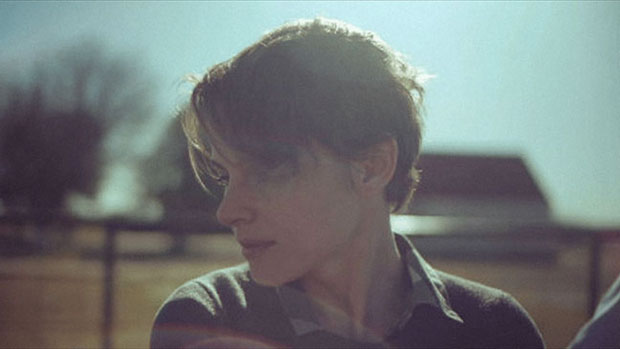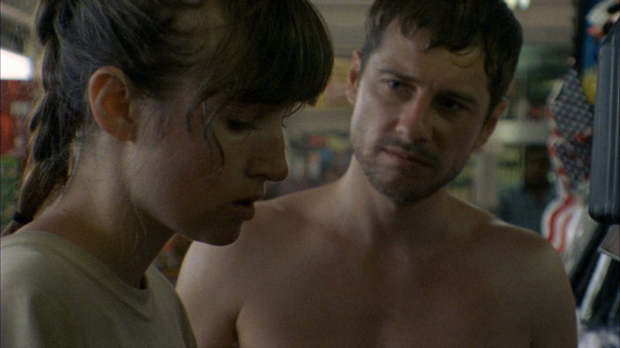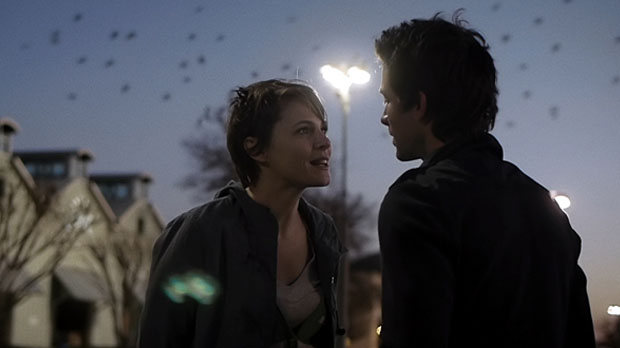 Back to selection
Back to selection
Amy Seimetz Breaks Through

Collaboration may well be Amy Seimetz’s favorite word. Some derivation of the noun weaves its way into the multihyphenate’s emphatic speech when discussing any facet of her decade long career. It’s how she found her footing, and how she has been able to surmount an impressive and far-reaching presence in independent film, and now, television.
Seimetz began making films when she was 18, at home in the Tampa-St. Petersburg area, a place she frequently returns to in life and work. Following a short-lived tenure at film school, Seimetz made her way to Los Angeles, where she met the experimental filmmaker James Benning and the cinematographer Jay Keitel. While the former deeply impacted her work, the latter, Seimetz says, “spawned the idea that I could work collaboratively with someone forever.”
While establishing herself in Los Angeles, Seimetz worked as a nanny, a waitress, and a seamstress. One potential source of income that was never part of the equation, however, was acting. Though she is now one of the most recognizable faces in independent film, Seimetz says she only started acting in her own films to teach herself how to direct: “I was learning how to do the things I wanted people to do while learning how to direct. They were born out of each other, I don’t see them as separate entities. It’s all filmmaking…I don’t think I could continue as an actor if I couldn’t continue making films.”
Enter Joe Swanberg. Introduced via their mutual friend Pat Healy, Swanberg cast Seimetz in Alexander The Last, which resulted in “people wanting to put me in their movies and pay me for it.” To put it mildly. Since 2009, Seimetz has racked up nearly 40 acting credits in shorts, features, and television, but there is not the slightest air of self-importance when speaking of her on-screen ubiquity. For Seimetz, it was all but a means “to be around people who were making things and collaborating.”
Her most recent onslaught of films, from 2011’s The Off Hours and A Horrible Way to Die to Upstream Color (which opens this Friday) and the upcoming Pit Stop, were all shot after Seimetz returned home to Florida, a move that imposed a separation from more traditional film metropolises. “I didn’t feel like I needed a system to continue making work,” says Seimetz. “I didn’t need to be in L.A. or New York. It was a fruitful period of time for understanding what it meant to be an artist for life. All of my tools were self-contained, and if anything was going to happen, it was going to be me making it happen.”

Happen it did. Last year, Seimetz wrote, directed, produced and co-edited Sun Don’t Shine, her first non-experimental feature, shot on location in St. Petersburg, and due for release by Factory 25 on April 29. Starring her friends Kate Lyn Sheil and Kentucker Audley, Sun Don’t Shine is a carefully plotted character study under the most dire of circumstances. Spurred from a recurring nightmare, it was Audley who put Seimetz up to realizing the tale of a tormented couple on the run. “In a way,” she says, “the film wrote itself. Making the film was a means of discovering why it kept coming back.” Seimetz was going through a rough time personally, and the story clicked on a visceral level, which she says is essential for making anything. “I felt like I was slowly going insane. Facing death was ruining a lot of my relationships, and the way that I related to the world. This was a good caveat to explore that. Put a body in a trunk and suddenly you cut yourself off from the rest of the world. You’re isolated once you cross that boundary. You’re unable to relate to the world in which you live.”
From the opening frame of Sheil gasping for air against the blue sky above, the viewer is thrown headfirst into a narrative that’s already well underway. “I hate exposition,” Seimetz smiles, “as a film viewer and an actor.” Speaking about her proclivity for in medias res and “no effort in the setup,” Seimetz touches upon the teachings of James Benning. “I like it when it’s like I’m taking a walk, and suddenly there’s someone beside me, and now we’re in a narrative together.” Another point of interest for Seimetz, both visually and thematically, is a sense of voyeurism. She strives to capture “a series of intimate moments where there’s eventually the realization that it was all building towards something.” Returning to Benning’s walk analogy, “I can see my end goal, but it’s hard for me to keep a straight line. There’s a lot of ways to get to that end point, and it bores me to be direct about it.”
It’s a creed she applies seamlessly to her new short, When We Lived In Miami, a veritable collage of moments in the life of a mother (Seimetz) whose marriage is falling apart in the face of an imminent hurricane. Thematically, the 13-minute film sees her touching upon another one of her favorite topics: “bad” women, albeit from a reverse angle. As demonstrated by Sheil’s Crystal in Sun Don’t Shine, Seimetz is fascinated with “women who don’t know how to be good women, and the existential crises for women who reject motherhood.” She continues, “Women are taught at a very early age that they need to be a ‘good girl,’ that you need to play nice. Whether it’s a relationship or feminism, your goal is to be ‘good’ at it. You have to pick a side. Be a feminist, or don’t be a feminist. Be a mom, or don’t be a mom.” If Sun Don’t Shine is Seimetz turning this societal norm on its head, When We Lived In Miami subversively taps into the “good girl” ideology, with Seimetz’s character desperately struggling to hold her family together.
When asked how directing herself at present has evolved from doing so at the beginning of her career, Seimetz shrugs it off. “With When We Lived in Miami, I put myself in it to be able to direct this little girl (Fiona D’Avis, who plays her daughter), to maintain trust and fluidity of performance, so she didn’t have to take what I was saying and apply it to another person. My decision to act in it was more of a directing decision. Not only that,” she laughs, “but I also really wanted to smash up a car. That sounded like fun.” And of the shorts she directed and starred in in the late 2000s, notably 2009’s Round Town Girls? Seimetz’s eyes widen and she launches into an impassioned tangent on her collaborator Mary Bronstein, and their brutal film about gutter punk girls who terrorize men for laughs and cash. “I think Mary Bronstein, and [the other co-director] Ronnie Bronstein, are two of my favorite filmmakers, and two of the greatest minds that are in independent film. They come up with these ideas of what human nature is, and take it to the most extreme. There are not many people who do it like they do. I was fascinated by Mary because she’s such a strange, wonderful woman, and I love strange, wonderful women. She’s complicated, and difficult, and angry, and a mom, and so lovely. So I just wanted to do this movie with her.” Her individual responsibilities of acting and directing, again, seem like only an afterthought. Seimetz commits herself to a project because of her enthusiasm for her collaborators, for the entire filmmaking process, and of course, the character and subject matter—especially when there’s a “bad” woman in the equation.

While she was cutting Sun Don’t Shine, Seimetz was asked about starring in a film that, on paper, shares some commonalities with her debut — both examine two people struggling to regain control over their lives. Shane Carruth came to Seimetz through her co-editor, the filmmaker David Lowery, in search of a kindred spirit who could respect and realize his vision. Carruth asked her to audition for the role of Kris. Seimetz declined, instead offering him a rough cut of Sun Don’t Shine. It did the trick, and soon after, Seimetz found herself in Texas on the set of Upstream Color. “We’re almost kind of the same person,” Seimetz says of Carruth, who does everything from scoring to photographing his films. “He has such a clear idea of what he wants, it’s just easier to do it himself. The same way he was an engineer who taught himself filmmaking, I taught myself how to sew to make money. We come from the same place, that you can find a way to do anything.” They also share an all-consuming passion: “I want to [make films] with the same people who have the same curse I do, that we’re compulsive. We just want to make a good movie, and we’ll go to the poor house to do so.” While Upstream Color will likely propel Seimetz towards her broadest audience yet, comprised of critics and Primer devotees alike, it’s only a matter of time before she reaches an entirely different viewer through the medium of television.
Back in Florida and shooting When We Lived in Miami, Seimetz received a call from her agent that Christopher Guest wanted to meet her in Los Angeles. She was, to say the least, skeptical. Her agent assured her that she was only one of two people he was interested in for a role on his HBO show Family Tree, and that she had to go out and speak with him. Fretting that he would have her audition on the spot, Seimetz was relieved when all they did was talk for an hour. On her flight home, Seimetz recalled thinking, “That was amazing. I just sat and talked to Christopher Guest for an hour, and he’s kind of my hero. I felt almost like, ‘I don’t care if I get it, I’m just so happy I got to sit and talk to him.’” Later, once she got the part, which was “mind blowing,” she found out that Guest doesn’t audition actors, a revelation that Seimetz describes as affirming. “He keeps it all in the family, being loyal to the people that you work with, knowing when you meet someone, ‘We’re going to work together. I’m not going to make you prove it to me, we’ll find it together in this supportive environment.’” Seimetz, for her part, only writes for people she knows, even flinching at the term “hire.” Because Seimetz and Guest shared this like-minded, collaborative outlook, her “transition to television didn’t feel like a transition at all.”
Seimetz’s next and current television project, however, would be a little different. Seimetz was planning on directing another film when her friend, the actor Jane Adams, began prodding her about a role on The Killing. Adams was convinced that no one could play Danette Lutz — a financially strapped single mother whose daughter goes missing — other than Seimetz. Seimetz wasn’t sure if she wanted to do television again given the time commitment — shooting straight from February to July — but loved the show, and went in for the part. When she saw that a casting director sent her agent an email that read she was “too sweet” for the role, Seimetz says, “the Florida came out in me.” She demanded to go in for another audition and won the role. “As soon as they said that, it was like, ‘No, no, I know this woman. No one knows this woman more than me,’” she nods, echoing Adams’s words. “I fell really in love with the part, and it’s the only thing I’ve ever really fought for, and I won.”
In comparing her work on The Killing to Family Tree, Seimetz feels the biggest difference starts with the director. “On Family Tree, Chris Guest directed everything, but on The Killing, you have a new director every single episode. You do have the support of the showrunner and head writer, Veena Sud, and she’s there to see it through, but it’s constantly about figuring out how all those different moving pieces work. [Veena and I] are figuring out the overall direction the character is going to take, but the moment to moment is directed by someone new. It’s a different style of working.” Still, Seimetz is thankful she’s able to spill over into television and not necessarily Hollywood: “I look at larger film roles, and they’re unappealing to me, but television has gotten really good. Going back to the love of the slow burn, a character doesn’t have to explain herself every time she walks onto the scene. She has 12 whole episodes for us to understand who she is.” She’s also enjoying a break in responsibilities, relative to the set running she does in the independent world. “Being able to show up and just perform is such a blessing, because I’ve done producing, directing, editing all at once, and it never ends.” Seimetz jokes about waiting for the shoe to drop, when everyone finds out that she’s not even acting, “just experimenting with ideas,” but agrees that mastery of the craft is besides the point, that you’re meant to be on your toes at all times.
When I ask if her inner director ever encroaches on her outward actor in these new professional settings, a devious look comes over her face. It can be hard keeping her thoughts to herself, coming from such a collaborative background, but she’s also found that many of the directors on The Killing are receptive to her ideas. “I think they’re excited by it. We’re all there to make it the best possible show it can be.” It’s not a trapping to know too much. “[The filmmaker in me] is part of my performance process, because I understand where the camera is, where the movement of the scene is, I can feel when it gets stale in the moment. The more you know the whole 360 degree angle of it, the more active you can be in understanding what world we’re creating. When you’re off camera, you know how to still give to the person on the other side, and to still give 100%, because it’s worth it for the little moments.”
It’s the sort of trust and ethic that she expects and receives from collaborators on her films. “I trust everyone that I’m working with, and I make it a point to — I won’t say “hire” because it doesn’t feel right — but bring in collaborators that can really bring something to the project. Jay Keitel, my d.p., and I really respect the term ‘director of photography,’ is a filmmaker, just like the way I think Kate Shiel is a filmmaker, who’s actually written something and is co-directing it right now, and she hadn’t before, but I thought, ‘You’re a brilliant storyteller.’ I look for that in actors, and I see all my actors as filmmakers because they get the whole picture.”
Once The Killing wraps in July, Seimetz hopes to shoot a new script, which she describes as tonally different from previous works — “dark but comedic” — and in increments, as she did with Sun Don’t Shine. “We went out, shot for a week, edited it, figured out what exactly we were making, trusted it, I did rewrites based off of those discoveries, and then we went and finished it.” As for the location, she’ll be bringing her team back to Florida. “When I was younger, I thought I needed to move to a place that was cultured, and I was so arrogant. I thought in New York, L.A., and San Francisco, people know stuff, but then I realized, everyone’s just trying to figure it out. I go back home, and something inside of me just clicks and feels right.” In many ways, it’s a fitting setting for a filmmaker who likes to keep things personal.
